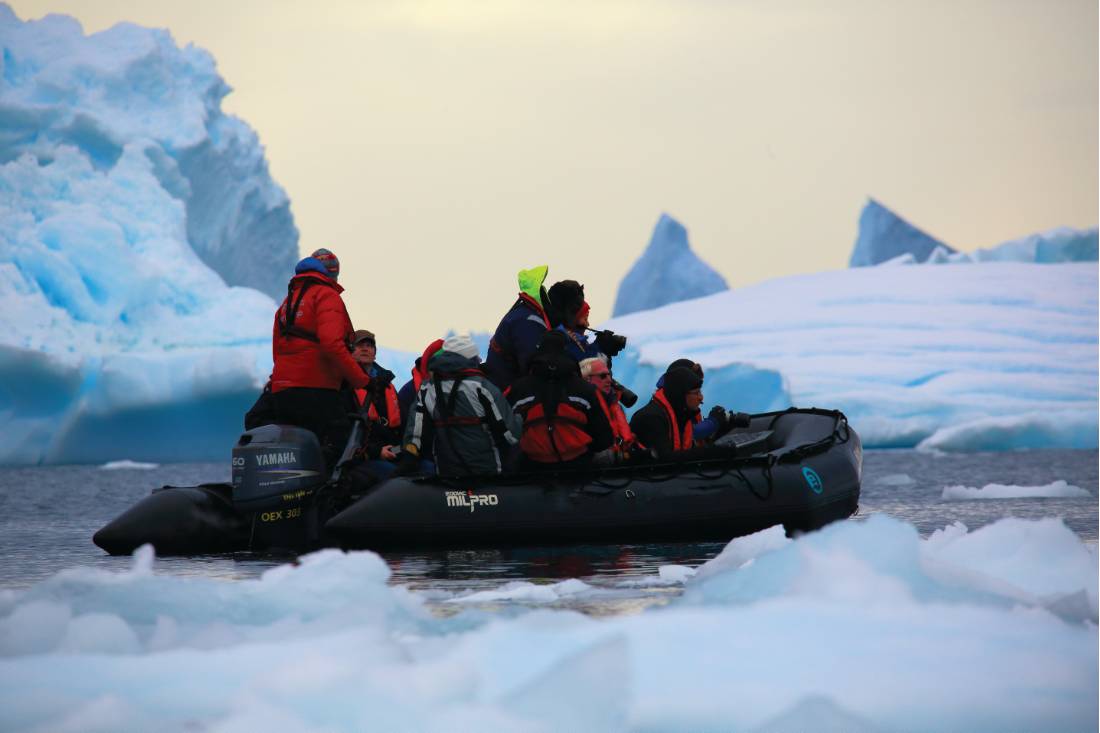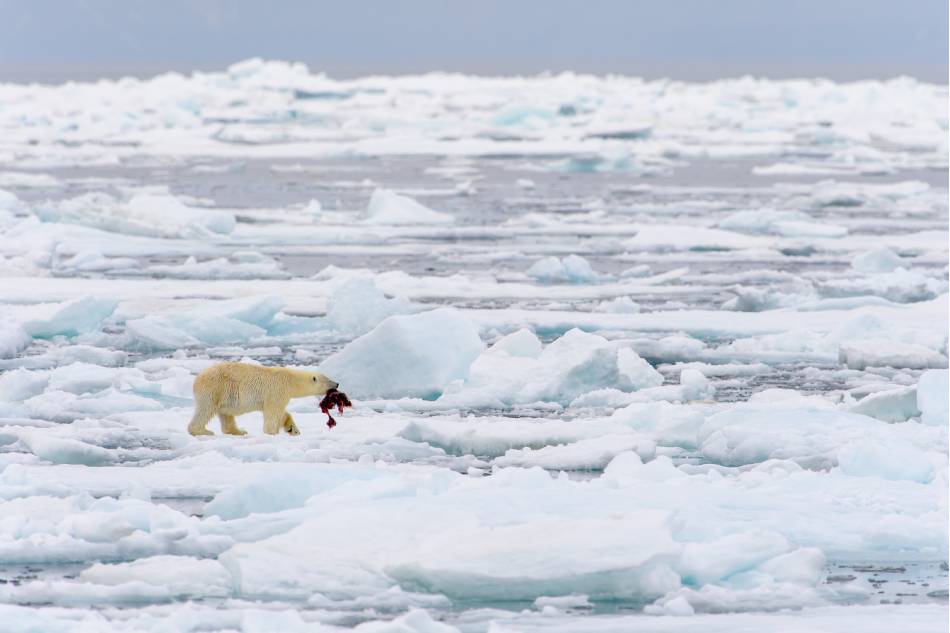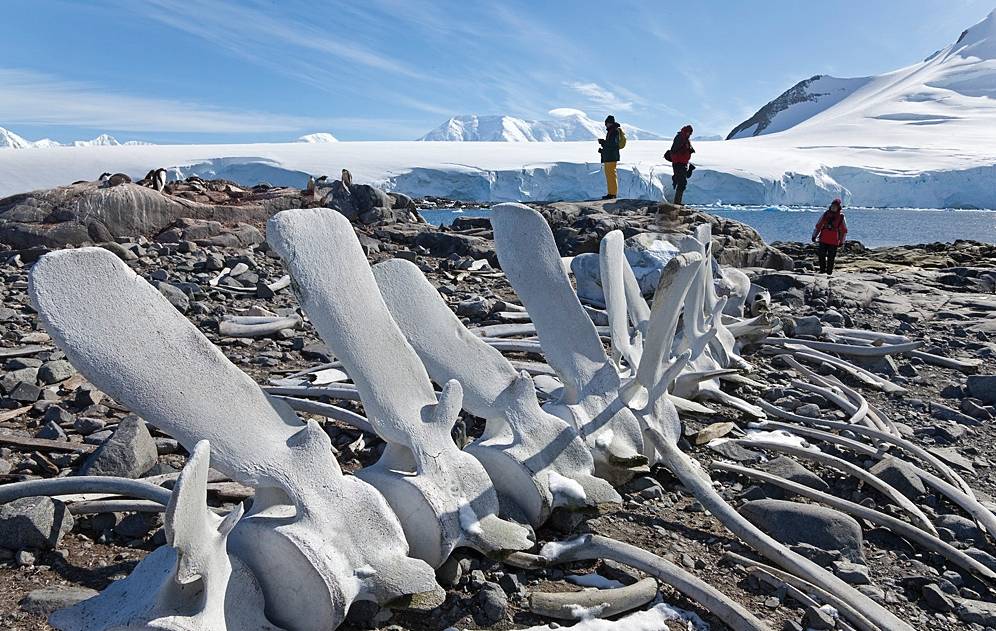Blog home / On The Couch: Our Polar Cruising Expert Rachel Imber Shares Her Tips
Rachel Imber is a veteran of six Antarctic/Arctic trips going to eight destinations. She has been with World Expeditions for 20 years and helped countless people get the best out of their itineraries. We sat down with her and asked her about the polar regions and what advice she’d give travellers, and what she liked most.
Which trips have you done to the Antarctic/Arctic?
I’ve done six, which included visits to Antarctica, South Georgia, The Falkland Islands, the Russian Arctic, Svalbard, Greenland, the Canadian Arctic, Macquarie and Campbell Islands.
The longest was…?
The Falklands, South Georgia & Antarctica, a 23-day trip.
What’s the most interesting thing you’ve seen on an Antarctic/Arctic trip?
Six male polar bears sharing a beach at Herald Island in the Russian Arctic. They were gathered around a walrus haul out. The males don’t normally congregate like that but they can late in summer before the ice returns.
What’s your favourite trip?
South Georgia is just this phenomenal, glaciated sub-Antarctic island, with an incredible amount of wildlife. It’s just spectacular…you’ve got the history (e.g., Shackleton), you’ve got incredible wildlife, and the scenery is just mind-blowingly beautiful. Every time you go around a corner into another bay it just takes your breath away. Another favourite trip of mine up north would be North Spitsbergen in Search of Polar Bears. If you go early in the season you’ve got a better chance of seeing bears on ice.
What are the most common questions people have when looking at Antarctic/Arctic trips?
What the seas conditions will be like? Will it be rough? How cold will it be?
How many people will be on the boat? How much wildlife will I see? And will I get seasick?
The Southern Ocean is pretty mighty, and it does get rough, but it’s not always rough. The worst conditions I’ve seen were in the area around Macquarie Island. The Scotia Sea (between South Georgia and Antarctica) and the Davis Strait (between Greenland and Baffin Island) were also a bit rough. It all depends. At times the sea can be like a lake, hence you often hear the Drake Passage referred to as the Drake Lake!
Temperature-wise, here’s an example: in South Georgia you might experience days in January where you hit 5°, 6°, 7° if you’re out of the wind. In November in South Georgia, it might be zero, it might be a bit less than that. When the suns out it has a real intensity, so it feels much warmer. Wind chill can really change things. As with any place, when it comes to weather, you’ve got be prepared for whatever might come at you. The Zodiac rides will wake you up. You are very aware of things after a 15-minute zodiac ride to the shore.
...this isn’t just a trip, it’s a life investment.
What about price?
Costs are a concern. These trips might be a bit costlier, but they are life investments. Once you’ve done the trip, most people agree that the value gained outweighs the amount spent. They are just that special.
Cabins types is another question we get. The truth is you don’t need the nicest cabin in the world. The whole idea of these trips is to be out experiencing the environment, so you don’t spend a great deal of time in the cabin. Sure, you can go inside and get warm and charge cameras and whatever, but the idea is to be out of the cabin as much as possible.
Sea sickness is another concern. It can be bad, but generally the people who suffer from it only suffer for a day or two, then most people find their sea legs. So, yes, it’s there, and you might have a short period where you don’t feel fantastic, but it usually subsides. Sometimes your appetite can be a little bit off, too, but you generally steer your way through it.

What are the biggest myths people hear about Antarctic/Arctic trips?
Cruising appeals to the older generations, but that’s definitely not the case for the expedition cruises that we do. We get a younger demographic on trips like these.
Another myth is that all cruises offer chances to go ashore; many of them don’t. They just cruise past but include no landings.
That all cruises to the Antarctic and Arctic regions do the same thing. Itineraries can change because of weather, season and/or ice conditions. No two trips are ever the same. Itineraries are a guideline of possibilities only.
What about wildlife myths?
One major myth is that it’s okay to approach wildlife when there’s so many animals in one place. It’s not true and there are rules that should be abided by. If the animals approach you, then that is okay. For example, penguins are quite curious. I’ve had a few come up to me. King penguins (the second largest of the species) are quite tall especially when you’re sitting down. They’ll come over and they’ll look at the camera, they’ll peck at your clothes.
I’ve had a weaner (baby elephant seal) come and sit in my lap, and those sorts of interactions are fine. Once their mums go out to feed and leave them on the beach they gravitate to gear and people. They just want to cuddle.
I’ve been in a Zodiac where a gray whale has literally come up and flicked water into the boat with its pectoral fin. Just playing with us. You do get some unique wildlife experiences. I’ve had mornings where we’ve been in a bay where there’s probably 60 whales, three different types, all breaching and feeding.
We have more than 60 different Antarctic and Arctic voyages. What might not be obvious to people when they start comparing trips? What are the things you’d suggest they pay most attention to?
What are your expectations? What are you hoping to get out of the trip? If someone says I really want to see a polar bear on ice or I want to push through ice in the boat, then you’d want to look at a trip that goes earlier in the season rather than waiting late. Look at the duration of the trip. How long are you going to be out? Does that help your chances of getting to see what you want?

An example?
The Lemaire Channel (on the Antarctic Peninsula) is a great example. Some clients hope to sail through the channel but early in the season it can be clogged with ice. So, you wouldn’t want a November departure, obviously. You’d want to wait until later in the season.
If you want to see a King Penguin, for example, you have to go to South Georgia or Macquarie Island. You won’t see one on the Antarctic Peninsula. Also, not a lot of voyages cross the Antarctic Circle. They run those trips late (because of the pack ice). That’s usually the only time you can push far enough south to make it to the Circle. Some people want to go for history, some people want birds, some people want whales…and whales are better later in the season.
What are your top Antarctic and Arctic trips and why?
Antarctica, Falklands, and South Georgia because it offers the ultimate in wildlife and diversity. You see the sub-Antarctic conditions around South Georgia and when you get down to the White Continent you get that complete contrast between the two areas.
The Base Camp trips are excellent because they’re a chance for participants to try all the activities we offer: kayaking, climbing, camping. On those trips the activities are no extra cost. That kind of trip is for someone who maybe says, “I want to try all those things but I’m not a strong kayaker.” If you want to kayak every day, then that’s not the trip for you. There are other trips that would suit you better.

Polar Plunges?
Yes. Polar Plunges! Almost every trip offers a chance to plunge. You get back on board and there’ll likely be a crew member waiting with a shot of vodka or something to help warm you up. It’s like having an ultimate face lift. Your skin feels great for about two days. It’s nature’s Botox.
What things do you wish you knew before your first Polar voyage?
What an assault on all your senses it would be! You’re in this environment with the cleanest air, there’s absolute stillness and quiet, and then a glacier calves and there’s this massive cracking. It’s just phenomenal. You get to a penguin rookery with a million birds, and it’s so noisy and the smell is overwhelming. You get so much sensory stimulation.
I didn’t need a lot of specific clothes. You just need really good layers and waterproofs. The ships are heated and you can just wear your normal clothing onboard. You always carry your big jacket in case someone spots a whale or something and you need to run outside.
What about Zodiac landings?
Gumboots are provided on cruises for wet landings. There are cleaning stations on the ship. So, getting on and off the boat the boots go through a brush and water cleaning system to make sure we’re not carrying anything that can contaminate the environment or spread disease.
Also, I didn’t realize how amazing seabirds are until I went on my first polar trip. You’ll see wandering albatrosses that just soar alongside the ship. Then there are things like Arctic terns. They’re tiny. They migrate from one pole to the other every year – that’s about 30,000 kilometers. I was pretty blown away.
Getting away from the pressures of normal life and into a pure wilderness environment – I love the opportunity to disconnect and leave the modern world behind.
What is the advantage of booking with World Expeditions?
We help people match their goals with an itinerary that gives clients the best chances of making them realities. We help clients consider what time of the year, how long a trip, the area, even with packing. Helping people meet their expectations is really what we’re known for. And, those of us consulting have a lot of experience with these trips ourselves.
We only sell trips on small expedition-style boats, which is really important. We know the nuances between the boats. They’re definitely not all the same. The boats we use come with stellar crewmen and women. Our leaders and expedition crew are super experienced, and they absolutely love what they do. Like I said, this isn’t just a trip, it’s a life investment.